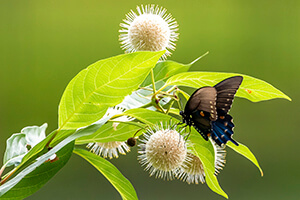
A black swallowtail butterfly hanging around a button bush.
Georgia native plants are a sure bet for your landscape, especially because they are naturally adapted to our growing conditions in Northeast Georgia, and they attract pollinators and birds.
Recently, Garden for Wildlife announced its top picks for Georgia natives, including buttonbush and scarlet hibiscus.
Buttonbush has white ball-shaped flowers that look like golf balls with spikes or pom-poms. Very fragrant, they attract many pollinators, including native bumble bees, honeybees and butterflies. Plant it in full sun near a water source because it likes wet areas. Choose it for a rain garden or an area where you need to control erosion.
Blooming throughout the summer, it also provides garden interest in the fall. The blooms become reddish-brown balls that provide food for wildlife and provide some fall and winter interest in the landscape. It can grow up to 10 feet tall and can stand some pruning to keep its growth in check.
Button bush is a great substitute for the common butterfly bush, which is considered an invasive species by the Georgia Native Plant Society. The seeds of some types of butterfly bushes can easily spread and take over a garden. However, there are new hybrids that are sterile; they don’t produce seeds and can provide beautiful color.
Button bush is a perfect alternative that’s also a host plant for moths and a food source for birds.
If you’ve seen the large white, pink or red dinnerplate hibiscus in people’s yards, you’re looking at hybrids of another native species: hibiscus coccineus, also known as a swamp hibiscus or scarlet rose mallow. The native species features bright scarlet star-shaped blooms with five petals and the distinctive pistil of the tropical hibiscus.
While the beautiful hybrids made a stunning statement with blooms up to 10 inches across, the scarlet rose mallow are more common in swamp and coastal areas. It can be planted along the edges of ponds or in containers in Northeast Georgia.
Check out the Georgia Native Plant Society for a local chapter and for information about other native plants for our area at www.gnps.org.
Tomatoes in containers
This winter, we started our tomato seeds indoors, planting eight different types of heirlooms and new hybrids. Thanks to the National Gardening Bureau, I received a nice selection of seeds right after the first of the year that included some of my favorite heirlooms, such as Cherokee Purple and Mortgage Lifter and my favorite hybrid cherry tomato Midnight Snack.
Additionally, the All-American Selections included seeds for Chef’s Choice Orange and Chef’s Choice Yellow, Purple Zebra and Brandywine.
Once the seedlings were repotted then hardened off about 10 weeks after sowing indoors, we quickly ran out of room in our raised beds. We shared seedlings with friends, but I couldn’t stand to part with the other 30 plants that were thriving.
Enter growbags. These amazing reusable bags, made of lightweight fabrics, are perfect to extend your gardening space. Last year, we lined our driveway with growbags planted with tomatoes and were able to harvest until the end of the summer.
Once again, our driveway is filled with tomato plants in growbags. I can’t wait until they start bearing. I see a couple of afternoons of canning in my future.
Here’s what you need to know:
- Choose an area with at least 8 hours of direct sunlight each day.
- Pinch off the lower leaves and plant the seedlings deep.
- Cover the soil with mulch to help reduce water splash back and retain moisture.
- Stake the plants to keep them upright.
- Fertilize them when planted; every three weeks thereafter.
- Water regularly, more often than those planted in your garden; containers usually require at least twice as much water as in-ground plantings.
You can use growbags year after year. Just toss the spent soil into your compost and wash out the bags to store over the winter.
Happy growing!
Photo: by Joyce Tipton






